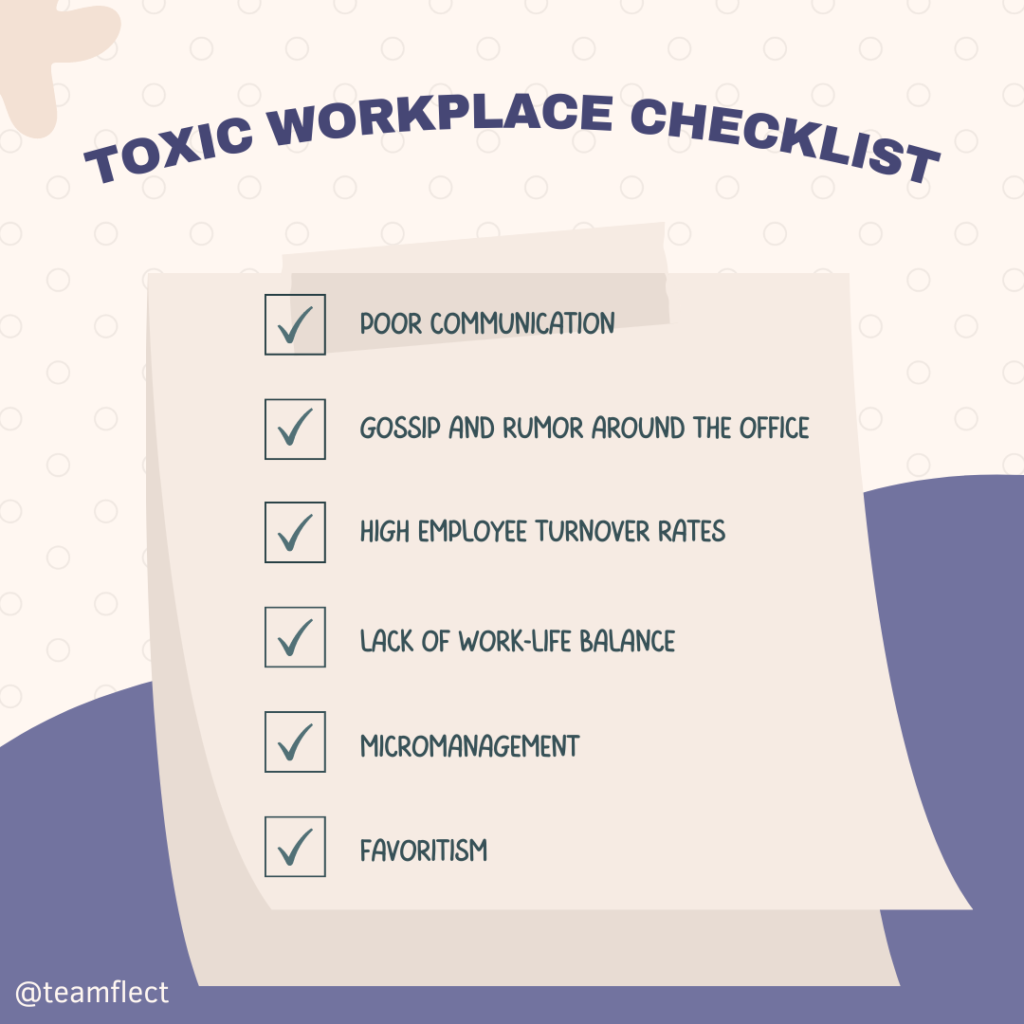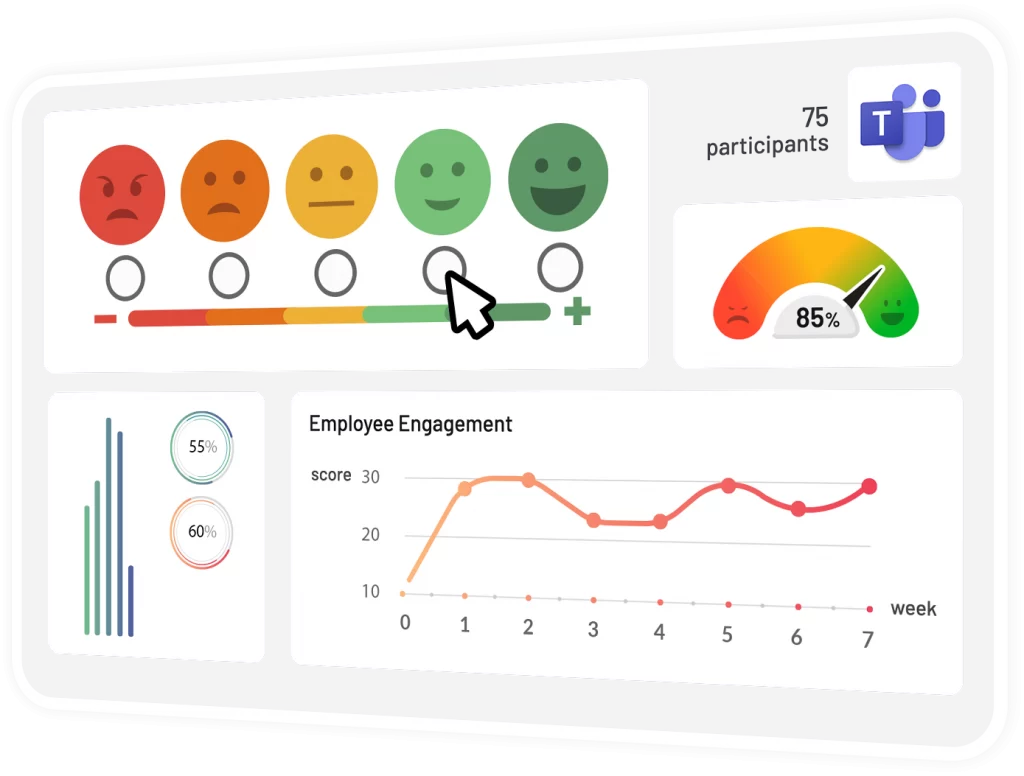We all want to believe the place we work provides us with a positive workplace culture, but that might not always be the case. Workplace bullying and staying in a toxic work environment are issues that are frequently encountered in the modern business world and fortunately, our awareness is increasing day by day.
Although these hard-to-talk-about subjects are getting more recognized by people and culture experts, employees and healthcare professionals, seeing the signs of a toxic workplace can be harder than it sounds.
That’s why in this blog post, we’ll talk about the signs of toxic workplaces with a toxic workplace checklist, and the impacts of and steps to take when dealing with a toxic workplace.
But let’s first talk about the definition of a toxic workplace before getting our hands on this issue. We can define a toxic workplace as a work environment where the behavior of colleagues, supervisors, or the company culture itself causes significant harm to employees’ mental, emotional, or physical well-being.
In a toxic workplace, employees may feel unsupported, undervalued, and disrespected, leading to a range of negative effects on their productivity, job satisfaction, and overall health. These toxic behaviors can include anything from bullying, discrimination, and harassment to micromanagement and unreasonable workloads.
Long-term exposure to a toxic workplace can lead to burnout, anxiety, depression, and even physical illness for employees. And it does not get better for organizations themselves! For organizations, a toxic workplace can result in high employee turnover, low productivity, and a damaged reputation.
We wanted to put together this blog post to help any employees struggling with bullying or negativity in their workplace but cannot put its name and therefore seek out help.
Everyone deserves to work in an organization that respects them and protects their dignity, and we are here to help managers and employees realize possible signs of toxicity in the workplace.
So, if you’re asking yourself “is my workplace toxic?”, let’s dive in!
Table of Contents
Signs Of A Toxic Workplace
1- Communication is weak throughout your organization
In a toxic workplace, communication is often poor or nonexistent, leading to confusion, misunderstandings, and frustration among employees. Important information may be withheld, and rumors may spread, causing unnecessary stress and anxiety in employees.
Maybe you needed some extra information on a task to complete it, but you never seem to get clear communication within your workplace.
We agree that communication is key in every aspect of human interactions, but it is especially crucial in a place where everyone works towards the same goals and vision. You may feel like your opinions and feedback are not valued or heard and face disengagement and reduced productivity.
It should not be a surprise that your employees need clear and high-quality communication to succeed or stay motivated. Whether it’s getting silent treatment in a romantic relationship or passive-aggressive behavior from your colleague, poor communication will cause toxicity and negativity in that place.
2- You hear gossip and rumors floating around
If you constantly feel like you’re in high school all over again with all the drama, gossip, and rumors, you might be facing a toxic work environment.
There’s nothing wrong with forming friendships with your colleagues, but even things that might seem like innocent comments at first glance can lead to a toxic culture.
Don’t get us wrong, small talk and sharing opinions are great around the office, but you get what we are worrying about don’t you? No, talking about the failed marriage of John from HR is not good for anyone, guys!
3- You don’t get effective or positive feedback
We are the advocates of healthy and positive feedback for the continuous development and progress of an employee here in Teamflect. In a healthy work environment, employees receive regular feedback from their managers or colleagues that helps them understand how they are performing and areas for improvement.
However, in a toxic workplace, employees may not receive any feedback at all or receive feedback that is vague, unhelpful, or overly critical, and this lack of feedback can lead to uncertainty, confusion, and low morale among employees, who may feel like their contributions are not valued or recognized.
In some cases, managers may use negative feedback as a tool for bullying or manipulation, creating a hostile work environment. If you notice that you are not receiving effective or positive feedback in your workplace, it may be a sign of a toxic workplace.

4- There is discrimination of any kind
We feel lucky to live in a time where diversity, equity, and inclusivity are important and sought after in a workplace, but unfortunately there are still organizations that don’t seem to care enough about these principles. That’s why facing any type of discrimination or inequality in your organization is another apparent sign of a toxic workplace.
Organizations and managers are responsible for creating a safe, inclusive culture for their every employee, and those organizations that don’t value gender equality, fair promotions and pay, equal opportunities, or creating a culture of empowerment face the risk of losing their best employees.
5- Employee turnover rates are high
Since this is the most obvious reason, we think it’s unnecessary to talk much about it. If employees come and go like the wind throughout an organization, it’s one of the prominent signs of a toxic workplace. No one wants to work in a hostile and toxic workplace for a long time, and working in a toxic culture can be one of the most draining experiences.
That’s why when employees notice they are facing toxicity and negativity, they seek a way out of that organization, resulting in high employee turnover rates. We know a couple of ways of decreasing employee turnover rates, and creating a positive work environment is indisputably #1.
6- You face unrealistic deadlines
Think about the last time your boss gave you a challenging and time-consuming task at the end of your shift and wanted it on his desk first thing in the morning. If you can’t seem to remember the exact incident or it did not happen at all –good for you!
But if this scenario is familiar and happened more than once or twice, you might be working at a toxic organization. Managers are responsible for the planning and following of given tasks, and giving employees enough time for completing tasks is crucial for both a healthy and ethical work setting.
7- Work-life balance is not provided
One step ahead of unrealistic deadlines is completely losing the balance between work and personal life. In a toxic workplace, employees may be expected to work long hours, including nights and weekends, without any consideration for their personal life or well-being.
Not getting provided a work-life balance is the main reason for employee burnout, workplace anxiety, and stress. In some cases, managers can use work overload as a tool for control or manipulation and create fear or anxiety. Working overtime without your consent or getting paid is one of the biggest signs of a toxic workplace.

8- There are signs of micromanagement
If there is no recognition or feedback from your managers on one side of the toxic workplace spectrum, the other part is getting micromanaged every second for sure.
In a micromanaged environment, managers excessively monitor and control their employees’ work, leaving little room for autonomy or creativity. Micromanagement causes frustration, decreased morale, and low job satisfaction among employees, who may feel like they are not trusted or valued.
Creativity and taking risks are important assets of a healthy, developing organization. If you have employees that are too afraid to take risks or potentially fail because of your constant monitoring, there won’t be any room for development too.
9- You sense favoritism around
In many toxic or corrupted workplaces, you can feel the favoritism around. You might feel like nothing you ever do is enough to get credit whereas your colleague is getting recognized for the bare minimum.
Favoritism can also come in the form of preferential treatment to friends and acquaintances by promoting them to positions of power without regard for their qualifications. Favoritism, nepotism and cronyism can lead to resentment, decreased morale, and a sense of unfairness among employees who feel like they are not valued or recognized.
10- There’s no room for professional development
In a healthy work environment, employees are given opportunities to grow and develop professionally, through training, mentoring, or other forms of support. However, in a toxic workplace, we observe a lack of support for professional development, leaving employees feeling stagnant and unmotivated.
Not supporting your employees for development causes decreased morale, low job satisfaction, and high turnover rates, as they may seek opportunities elsewhere that provide more growth opportunities.
Providing employees with the tools and resources they need to grow and develop not only improves job satisfaction and productivity but also leads to a more engaged and motivated workforce. Disengaged employees would not want to stay or develop in their professional roles.
Impacts Of A Toxic Workplace
Physical Health Issues
Working in a toxic workplace is like a tick bite –you don’t realize what’s going on until all your blood has been sucked, and then you’re left with the aftermath of the disease. A toxic workplace can have a significant negative impact on the physical health of employees.
When workers are subjected to continuous stress and fatigue, it can cause severe health problems over time. Long-term exposure to high stress levels can increase the risk of developing various health conditions such as heart disease, digestive disorders, and weakened immune systems.
If you’re working in a stressful environment, you might also feel frequent headaches and migraines, which can significantly impair your ability to carry out daily tasks. These physical health issues can be a significant cause of concern for both employees and management alike, as they can have long-lasting effects on an individual’s overall well-being and job performance.

Mental Health Issues
Impacts of working in a toxic workplace are not just physical health problems, like headaches and high blood pressure that can arise from chronic stress –toxic workplace also takes a toll on your mental health.
Anxiety and depression are frequent flyers in this kind of environment, and it’s not hard to see why: when you’re constantly under pressure, unsupported, or undervalued, it’s tough to stay positive.
The employee burnout you experience in a toxic workplace can feel like hitting a brick wall at full speed, leaving you feeling exhausted, empty, and demotivated.
Employers need to recognize the impact of toxic work environments and take action to create a healthier, more supportive workplace culture since after all, mental health is just as important as physical health, and we all deserve to feel safe, valued, and respected at work.
Work Performance
After the severe consequences we’ve mentioned before in this part, work performance can seem beside the question, but we’d still like to mention these either.
When a workplace becomes toxic, it’s not just the employees’ health that suffers, but the overall productivity of the organization can take a major hit as well.
When employees are overworked, undervalued, and disengaged, it’s no surprise that they may start to feel unmotivated and unproductive, which results in decreased productivity, missed deadlines, and decreased quality of work.
Higher rates of absenteeism and turnover are also common in toxic workplaces. When employees don’t feel valued or supported, they may start to look for opportunities elsewhere. Your boss might not think about your physical or mental health, but the success of your organization also depends on a positive work culture!
Checklist For Identifying A Toxic Workplace
If you’re feeling uneasy about your workplace and suspect that it may be toxic, it can be helpful to use a checklist. Check these topics if you think your workplace is toxic:
A. Communication: Is communication clear and effective throughout the organization, or do you find yourself in a constant state of confusion or uncertainty? Are people willing to listen and engage in open dialogue, or is there a lot of gossip, rumors, or backstabbing?
B. Work Environment: What is the overall vibe of your workplace? Are people generally happy and engaged, or do they seem stressed out and miserable? Is the physical environment clean, comfortable, and safe, or is it dirty, uncomfortable, and potentially hazardous?
C. Leadership: What is the quality of leadership in your organization? Are your managers supportive, communicative, and fair, or do they seem distant, critical, or even abusive? Are they willing to listen to feedback and take action to improve the workplace culture?
D. Work Demands: How reasonable are the demands placed on you? Do you have a reasonable workload and enough time to complete your tasks, or are you constantly overwhelmed and stressed out? Are you given clear expectations and goals, or do you feel like you’re always in the dark?
E. Health and Safety: Does your workplace take your physical and mental health seriously? Are there measures in place to prevent illness and injury, or are you constantly exposed to hazards and risks? Is there support available if you’re struggling with mental health issues?

Conducting Employee Surveys
If you are a manager and want to measure the overall happiness and positivity among your organization and protect your employees from the potential harms of a toxic workplace, you should conduct frequent employee engagement surveys. The best way to conduct and analyze your next employee pulse survey is using an employee engagement software such as Teamflect.
As an employee engagement survey software, Teamflect is the all-in-one solution you’re looking for to measure and follow employee engagement levels throughout your organization. Unlike other employee engagement software that are designed first and then integrated to Teams, Teamflect works flawlessly with its seamless Microsoft Teams integration.
Using Teamflect, you can conduct surveys to measure employee engagement, performance, and get feedback, all in just a few clicks! And get this, you can do it all without ever leaving your Microsoft Teams chat. It’s like having a secret weapon that saves you time and hassle.

Teamflect isn’t just some boring tool to measure employee engagement, nope! It’s like a Swiss army knife for managers, with a ton of other features that make it a must-have for any Microsoft Teams user. It provides you with extensive reports through Power BI that analyze the survey results, so you can make informed decisions and adjust your strategies as needed.
And let’s not forget about the performance reviews – with Teamflect, you’ll never have to use those boring Excel templates again. The reviews are so comprehensive and customizable, it’s like having a tailor-made suit that fits you perfectly. You’ll be able to give your team members feedback that actually makes sense and helps them improve.
Key Features:
- The best pulse survey tool for Microsoft Teams
- Easy to navigate dashboard
- 360-degree feedback
- Task management
- OKR management
- Customizable feedback templates
- Customizable performance review template gallery



